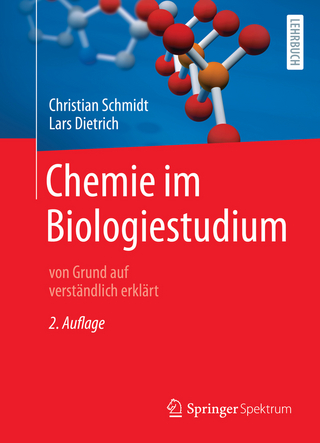
High-Density Sequencing Applications in Microbial Molecular Genetics
Academic Press Inc (Verlag)
978-0-12-815993-4 (ISBN)
Addition sections cover Global recognition patterns of bacterial RNA-binding proteins, High-resolution profiling of NMD targets, and the Generation of a metagenomic 3C/Hi-C library of human gut microbiota, Genome-wide mapping of yeast retrotransposons integration target sites, Measuring protein synthesis rates, Finding unsuspected partners of small RNAs with new screening approaches, Use of multiplexed transcriptomics to define the relationship between promoter sequence and transcription output, RNA-based control of quorum sensing in Vibrio cholerae, amongst other highly regarded topics.
Agamemnon James (A.J.) Carpousis is a Research Director in the CNRS. He graduated with honors in Biochemistry from the University of Pennsylvania and then did his doctoral studies in the Molecular Biology program at UCLA. His PhD work was on the mechanism of transcription initiation by Escherichia coli RNA polymerase. After postdoctoral research at UC Santa Barbara and the University of Geneva, A.J. Carpousis joined the LMGM, which is a CNRS Microbial Molecular Genetics Laboratory at the University of Toulouse. His research in Geneva contributed to the discovery that RNase E, which is an essential ribonuclease in E. coli, is a key enzyme in the initiation of mRNA degradation. In subsequent research, he purified RNase E and showed that it associates with other proteins involved in mRNA degradation forming a multienzyme complex, which is now known as the RNA degradosome. His group in Toulouse showed that RNase E has a composite structure consisting of a catalytic domain and a large non-catalytic region that serves as the scaffold for interactions with other components of the RNA degradosome. Other work includes studies on the role of RhlB, PNPase and poly(A) polymerase in mRNA degradation, and identification and characterization of beta-CASP ribonucleases in the Archaea. More recently, A.J. Carpousis and his colleagues showed that the RNA degradosome is localized to the inner cytoplasmic membrane of E. coli. They characterized a conserved element in the non-catalytic region of RNase E that directly anchors the RNA degradosome to the phospholipid bilayer of the inner membrane. RNA degradosomes on the inner membrane are highly dynamic forming short-lived clusters that are hypothesized to be centers of mRNA degradation. His group currently uses molecular genetics, biochemistry, high-density sequencing methods and super-resolution microscopy to address the question of the composition and supramolecular structure of the RNA degradosome clusters.
1. Characterizing the Role of Exoribonucleases in the Control of Microbial Gene Expression: Differential RNA-Seq Vânia Pobre and Cecília M. Arraiano 2. Conformational Studies of Bacterial Chromosomes by High-Throughput Sequencing Methods Virginia S. Lioy and Frédéric Boccard 3. Large-Scale Measurement of mRNA Degradation in Escherichia coli: To Delay or Not to Delay Sandrine Laguerre, Ignacio González, Sébastien Nouaille, Annick Moisan, Nathalie Villa-Vialaneix, Christine Gaspin, Marie Bouvier, Agamemnon J. Carpousis, Muriel Cocaign-Bousquet and Laurence Girbal 4. FASTBAC-Seq: Functional AnalysiS of Toxin–Antitoxin Systems in BACteria by Deep Sequencing Sara Masachis, Nicolas J. Tourasse, Sandrine Chabas, Olivier Bouchez and Fabien Darfeuille 5. The Challenges of Genome-Wide Studies in a Unicellular Eukaryote With Two Nuclear Genomes Sandra Duharcourt and Linda Sperling 6. CLIP-Seq in Bacteria: Global Recognition Patterns of Bacterial RNA-Binding Proteins Liis Andresen and Erik Holmqvist 7. High-Resolution Profiling of NMD Targets in Yeast Feng He, Alper Celik, Richard Baker and Allan Jacobson 8. Generation of a Metagenomics Proximity Ligation 3C Library of a Mammalian Gut Microbiota Théo Foutel-Rodier, Agnès Thierry, Romain Koszul and Martial Marbouty 9. Genome-Wide Mapping of Yeast Retrotransposon Integration Target Sites Anastasia Barkova, Amna Asif-Laidin and Pascale Lesage 10. Genome-Wide Quantitation of Protein Synthesis Rates in Bacteria Grace E. Johnson and Gene-Wei Li 11. On the Prowl: An In Vivo Method to Identify RNA Partners of a sRNA Marie-Claude Carrier, Claire Morin and Eric Massé 12. Analysis of Bacterial Transcription by "Massively Systematic Transcript End Readout," MASTER Irina O. Vvedenskaya, Seth R. Goldman and Bryce E. Nickels 13. Transcriptomic Approaches for Studying Quorum Sensing in Vibrio cholerae Roman Herzog and Kai Papenfort 14. In Vitro Study of the Major Bacillus subtilis Ribonucleases Y and J Liliana Mora, Saravuth Ngo, Soumaya Laalami and Harald Putzer 15. Mapping 5'-Ends and Their Phosphorylation State With EMOTE, TSS-EMOTE, and nEMOTE Peter Redder 16. MS2-Affinity Purification Coupled With RNA Sequencing Approach in the Human Pathogen Staphylococcus aureus David Lalaouna, Emma Desgranges, Isabelle Caldelari and Stefano Marzi 17. Noncoding RNAs in Archaea: Genome-Wide Identification and Functional Classification Anne Buddeweg, Michael Daume, Lennart Randau and Ruth A. Schmitz 18. Methodology for Ribosome Profiling of Key Stages of the Caulobacter crescentus Cell Cycle James R. Aretakis, Nadra Al-Husini and Jared M. Schrader 19. Transcriptome-Wide Analysis of Protein–RNA and RNA–RNA Interactions in Pathogenic Bacteria Jai J. Tree, Kenn Gerdes and David Tollervey 20. Profiling RNA Polymerase II Phosphorylation Genome-Wide in Fission Yeast Tea Kecman, Dong-Hyuk Heo and Lidia Vasiljeva 21. Toward Cell Type-Specific In Vivo Dual RNA-Seq Lutz Frönicke, Denise N. Bronner, Mariana X. Byndloss, Bridget McLaughlin, Andreas J. Bäumler and Alexander J. Westermann 22. Genomic Analysis of DNA Double-Strand Break Repair in Escherichia coli A.M. Mahedi Hasan, Benura Azeroglu and David R.F. Leach
| Erscheinungsdatum | 13.12.2018 |
|---|---|
| Reihe/Serie | Methods in Enzymology |
| Verlagsort | San Diego |
| Sprache | englisch |
| Maße | 152 x 229 mm |
| Gewicht | 1040 g |
| Themenwelt | Naturwissenschaften ► Biologie ► Biochemie |
| Naturwissenschaften ► Biologie ► Genetik / Molekularbiologie | |
| Naturwissenschaften ► Physik / Astronomie ► Angewandte Physik | |
| ISBN-10 | 0-12-815993-6 / 0128159936 |
| ISBN-13 | 978-0-12-815993-4 / 9780128159934 |
| Zustand | Neuware |
| Haben Sie eine Frage zum Produkt? |
aus dem Bereich


